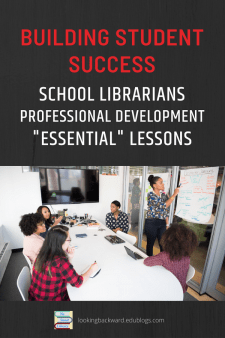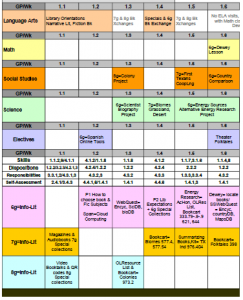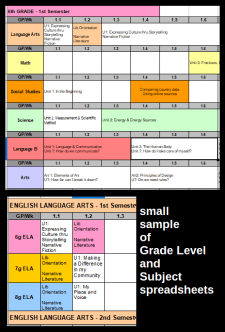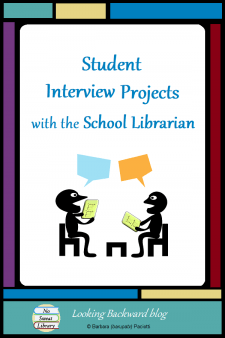 Who doesn’t love hearing stories and insights from interesting people? Interviews can spice up any student project and give students a new perspective on content they are learning. Middle schoolers especially enjoy interview projects and I can tell you they are a very creative bunch.
Who doesn’t love hearing stories and insights from interesting people? Interviews can spice up any student project and give students a new perspective on content they are learning. Middle schoolers especially enjoy interview projects and I can tell you they are a very creative bunch.
School Librarians can find several opportunities to integrate student interviews into collaborative lessons. Whether live interviews or mock interviews, the process is the same, and regardless of theme or topic, research and information literacy skills can be taught as students gather background for their interviews.
Let’s look at two popular projects in my middle school, one at the start of the school year and the other at the end.
A 7TH GRADE CROSS-DISCIPLINE PROJECT
During the 1st grading period of the school year, our 7th grade Social Studies students learn about the immigration of various groups into our State. During this same period, 7th grade English Language Arts students write personal narratives, so the teachers and I decided to combine the two assignments into a cross-discipline collaborative unit called “My Heritage—How and Why Am I in This State?”
Many students don’t know their own history of how they came to be in their State, so we ask them to interview family members to find out. This project gives students a sense of their own identity (important for middle schoolers) and provides a personal understanding of conceptual factors that have brought people into our State.
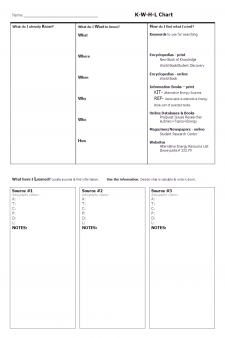 English Language Arts classes visit the Library first for a brainstorming lesson. I begin the Library Lesson with a read aloud: Allen Say’s picture book Grandfather’s Journey, a personal story of how he reconnected with his family background.
English Language Arts classes visit the Library first for a brainstorming lesson. I begin the Library Lesson with a read aloud: Allen Say’s picture book Grandfather’s Journey, a personal story of how he reconnected with his family background.
We pass out a KWHL worksheet (example from another unit at left) and I guide students in writing down what they Know about themselves and their families. Next I help them generate Want to know questions on the worksheet, which they take home and use to interview their parents—who are Source #1, which allows me to teach a personal interview citation. On a subsequent day in the classroom, ELA teachers model letter form and good letter writing so students can mail questions to family members living elsewhere.
State History Social Studies classes are the second Library visit. I tell students they are learning the history of themselves in the same way they are learning the history of our State. During this Library visit they will gather historical background on our State to answer W questions their parents couldn’t answer and also to create new interview questions.
I start with my Keyword Search Form and review search strategies so students can use various print and online primary and secondary sources related to State History, such as biographies and autobiographies; speeches, letters & diaries; and songs & artwork. I also model note-taking on the back of their KWHL worksheet—students have a tendency to write out everything, so modeling “Does this answer the question on my KWHL sheet?” keeps them focused.
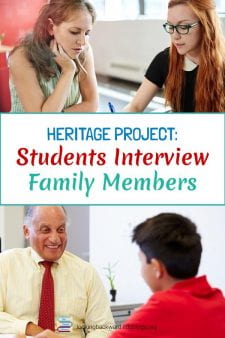 During the next few days students continue to gather information through interviews and research. We don’t expect a family tree from the time of the conquistadors, but every student can learn about the lives of their parents and grandparents. State History teachers help them compare and contrast the historical events they are learning about and the lives of their own family.
During the next few days students continue to gather information through interviews and research. We don’t expect a family tree from the time of the conquistadors, but every student can learn about the lives of their parents and grandparents. State History teachers help them compare and contrast the historical events they are learning about and the lives of their own family.
For their final product we offer students 3 product options—written, crafted, or oral, and two of them integrate technology:
- During a library visit I show students how to create a webpage so information can be shared with family members who live far away. Students learn that information displayed on the Web must be well-written and concise, forcing them to thoroughly think through and edit their research results.
- The crafted choice is a photograph poster of family mementos. For students who choose this option, I show them how to use our digital cameras and check them out, usually over a weekend. When they return I show them how to download and print out the images.
- 7g students enjoy playacting, so mock interviews or newscasts appeal to them. Students with common events in their background can group together to give “eyewitness” accounts. This helps students discern that historical “truths” often depend on one’s point of view—a valuable lesson as they study State history.
At a final Library visit we watch oral presentations, followed by a walk-around to view webpages on computers and crafted photo posters hung along the bookcases. It’s a great way to begin the school year and satisfies the curricular needs of both English Language Arts and Social Studies.
AN 8TH GRADE SPANISH TELEVISION SHOW
In the spring, our 3rd year Spanish students demonstrate their language skills with a group project en Español: a game show or an Oprah-type entertainment show, which we broadcast into the classroom through our closed-circuit TV channel. Both shows require students to do interviews, a short one for the game show and a more in-depth celebrity-type interview for the entertainment show. For this project we have 2 Library Lesson visits: at the first visit students learn about creating good personal interview questions, and during the second visit students learn how to prepare for the TV broadcast.
 The short interview is a 30-60 second introduction of the game show Players; the show host says “Tell us a little about yourself” and each Player responds with his/her fabricated character’s “bio”: home city/state (it can’t be ours), career or job, something about their family (this can be true or made up), and a favorite hobby, song, or movie.
The short interview is a 30-60 second introduction of the game show Players; the show host says “Tell us a little about yourself” and each Player responds with his/her fabricated character’s “bio”: home city/state (it can’t be ours), career or job, something about their family (this can be true or made up), and a favorite hobby, song, or movie.
For the in-depth interview I provide students with books on video & TV interviews and short celebrity biographies. I help them generate open-ended questions that prompt the responder to answer with greater depth and variety than just yes or no. The goal for both interviews is that students show their competence using Español, so we encourage them to be imaginative with their responses and in creating the activity.
The second visit is a Library Lesson about good “on-camera presence.” Students learn to look at the camera while answering questions, how to modulate their voice & pace their talking, to avoid distracting gestures, and about best on-camera colors for clothing. We critique demonstrations, then students break into groups to practice their TV shows, during which I schedule their broadcast times over the next week.
Watching the “on air” TV broadcast in the classroom lends an authenticity to this lesson that excites students. After we did this the first time, word got around the school that “Ms. P has a Television Studio in the Library!” and students from all grades began asking teachers if they could “do TV shows with Ms. P” for their various projects. A School Librarian can be kept pretty busy giving lessons on interviewing and then transmitting TV broadcasts to classrooms!
A RESOURCE FOR INTERVIEW QUESTIONS
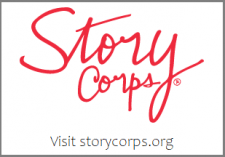 If you’ve never heard of StoryCorps, you’ll want to check them out. They began in 2003 with a Storybooth in Grand Central Terminal in NYC and they continue to give people a way to share conversations. They have recording sites, mobile story tours around the U.S., and an app on their website, all dedicated to providing a legacy of real voices that are archived at the Library of Congress.
If you’ve never heard of StoryCorps, you’ll want to check them out. They began in 2003 with a Storybooth in Grand Central Terminal in NYC and they continue to give people a way to share conversations. They have recording sites, mobile story tours around the U.S., and an app on their website, all dedicated to providing a legacy of real voices that are archived at the Library of Congress.
“Our mission is to preserve and share humanity’s stories in order to build connections between people and create a more just and compassionate world.”
“Great Questions” on their website is a wonderful resource that anyone can use to promote more effective and enjoyable interviews. (I receive no compensation for this endorsement.)



